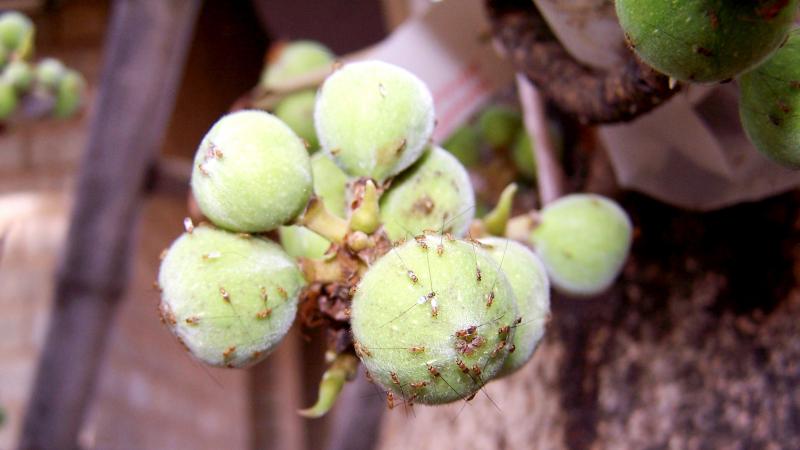
Some lives are incredible and exciting. Take for example the fig fruit. Hanging from the tree, these 'fruits' are in fact a group of flowers (inflorescence) enclosed in a globular 'fruit' that never see the light of the day. Also called a syconium, each of them has around 2500 flowers.
Another equally exciting life is that of a fig-wasp. These tiny insects play a significant role in pollinating the fig flowers. But, mind you! They do not do that for free! They lay eggs inside the syconium and have their nursery that feeds on the fig fruit.
In this happy fairy tale are villains called the non-pollinating fig wasps, which not only freeload inside the fig fruits, but also attack other fig-wasp nurseries. "These non-pollinating fig-wasps are parasites that have evolved to exploit this mutualistic system to their advantage. They lay their eggs inside a fig fruit without providing any pollination services”, says Dr. Pratibha Yadav, a researcher from the Indian Institute of Science. In a recent study, published in the Journal of Chemical Ecology, Ms. Yadav and her team detail the intricate process of how these parasitic wasps select their host syconium to infect.
The non-pollinating fig wasps lay their eggs in the hidden flowers of the syconium using a flexible drilling organ called the ‘ovipositor’ that can pierce deep into the syconium. There are two types of such wasps. The first type are ‘gallers’ who lay eggs on flowers and produce an abnormal outgrowth called a ‘gall’. Sycophaga stratheni, Sycophaga testacea and Sycophaga fusca are some of the common gallers. The second type, called ‘parasitoids’, complete their life cycle at the expense of gallers. Apocrypta sp. 2 and Apocrypta westwoodi are common parasitoids.
In this study, the researchers have detailed how Sycophaga fusca selects a suitable syconium to lay its eggs, and have compared its behaviour with Ceratosolen fusciceps, another species of pollinating fig-wasps. Laying eggs is an energy consuming task. The wasp has to choose the right host that provides food for its young ones and also keeps them safe from ant attacks. The wasps prefer the best host using chemical cues present on the surface of the syconia. These cues are about 17 volatile organic compounds released by a fig and specific chemical footprints left by each species of wasps on the surface of the fig when they visit.
The researchers found that S. fusca chooses a syconium that already has eggs from other S. fusca individuals since it increases the chance of finding a mate for the offspring, and also helps escape the defense mechanism of the host plant. Having many individuals in a single syconium also decreases the chance of attacks by predator ants, which also use the same chemical cues to identify the syconium. In addition, ensuring that the syconium is tried and tested by other S. fusca individuals is a way to make sure that the fig produces seeds and are not lethal for the wasp eggs.
The researchers also observed that S.fusca laid their eggs in a syconium that had up to 15 wasps laying their eggs. However, they completely avoided those syconia which had more than 20 wasps. The researchers attribute this behaviour to the wasp considering overcrowding the syconia as over-exploitation of resources since it stops the fruit’s further development -- a fatal blow to wasp progeny. Choosing a syconium with minimum inhabitants avoids competing with other peers to lay eggs and has many empty flowers to lay eggs.
When figs are infested by wasps, the plant secretes many volatile chemicals as a defence mechanism. When the researchers performed a chemical analysis of volatiles released from the synconia, they found that those only with C. fusciceps eggs had more of (Z)-3-hexanol, whereas those that had only S. fusca eggs had high amounts of methyl salicylate. The researchers also observed that fig syconia without any eggs had high amounts of benzyl alcohol. However, when the figs were exposed to both C. fusciceps and S. fusca, the syconia had higher proportions of (E)-β-ocimene. The researchers infer that wasps are highly sensitive to volatile cues and the release of such chemicals from syconia helps them to choose the suitable host wisely without spending much energy.
The study is one of the few that has explored the lives of parasitic fig-wasps and the smart tactics they use to survive. “Understanding the behaviour and mechanism of parasites in one system can help us understand the biology of parasites in other systems also. It may then help us in developing natural ways of pest management which is especially relevant now when pests are becoming increasingly pesticide resistant”, says Ms. Yadav, talking about the implications of this study.
